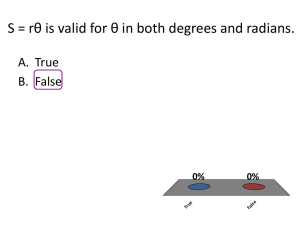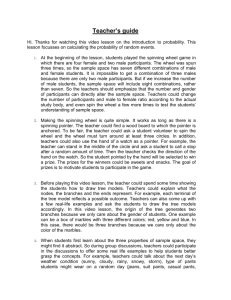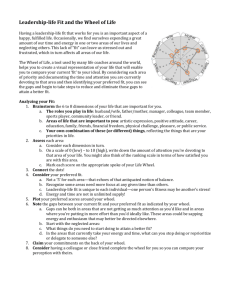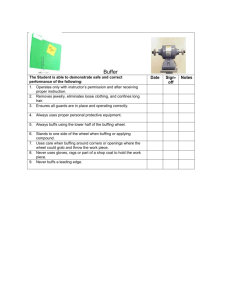Session 73: Spinning History ()
advertisement
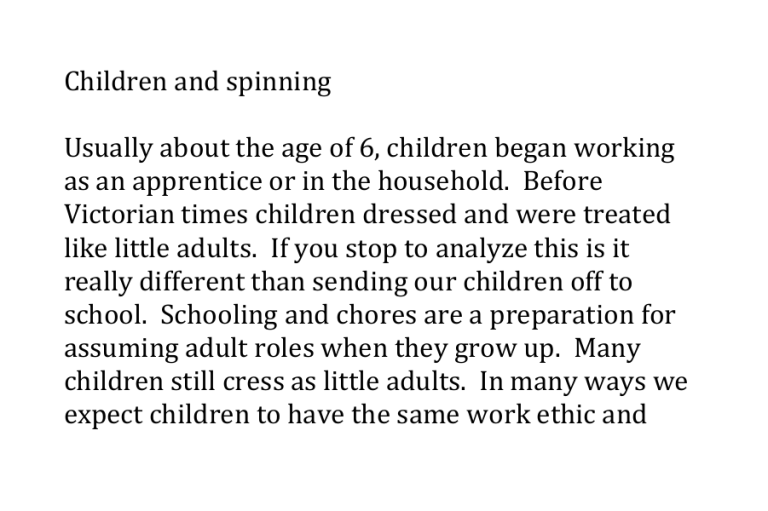
Children and spinning Usually about the age of 6, children began working as an apprentice or in the household. Before Victorian times children dressed and were treated like little adults. If you stop to analyze this is it really different than sending our children off to school. Schooling and chores are a preparation for assuming adult roles when they grow up. Many children still cress as little adults. In many ways we expect children to have the same work ethic and stamina that adults give to their jobs. However, in our development we have learned that there are developmental differences between children and adults. Children today are allowed more leeway and freedom to be children. As always, some parents have taken that to the opposite extreme and children are remaining children longer. So in colonial times children preformed many chores in the household working side by side with their parents. Boys worked with their fathers and girls with their mothers. In spinning the child might start with winding the yarn off the bobbin in preparation to plying, wind skeins, or balls. They would learn to spin on the drop spindle before advancing to a wheel. They would clean and card the fibers for the spinner. Eventually, they would take on a large portion of the spinning. It was common for all the women in the household to work on the spinning in the evenings. Related skills needed would be weaving, knitting and sewing these yarns and threads into items needed by the family. Items would vary from bed sheets to going to Sunday meeting clothes. History of spinning Spindle spinning has been round since people began weaving. Before the 15th century spindling was the only way to make yarn and thread. Think mummy wrappings, sails for ships, all spindle spun. Yarn and threads are used to make woven and nonwoven cloth, knitting, crochet, lace making, tatting, sewing, netting. Think back into history: Where would people use or have a purpose for cloth, yarn or thread? Where is cloth, yarn, thread used in the world? What are some of the earliest cultures that used, cloth, yarn or thread? What area some non-clothing uses for cloth, yarn or thread? Qualities required of a textile is flexibility, strength and some elasticity Fibers made from plants Are made of cellulose and there are 3 main groups 1. bast fibers: those that com from beneath the surface of the stem EX: flax, hemp, jute and rami 2. leaf fibers EX: sisal 3. Seed fibers EX: cotton Animal Fibers Base of protein Again 3 groups 1. Wool from sheep 2. Hair (closely related to wool) EX: camel. Goats ( angora=mohair, cashmere, llama, alpaca, vicuna, rabbits (angora), dogs, cats, some cows, buffalo, ox 3. Silk. A continuous filament produced by the silk worm while making a cocoon and silk waste which is short and can be spun like other fibers Asbestos is the only fiber made from a mineral Man made fibers were not discussed. Most likely because my main source of reference was written in 1976. Also this is an English book and the US isn’t mentioned. Now you are seeing fibers out of milk, bamboo, soy, Most people spin natural fibers and mainly the animal fibers. Because that is what our ancestor used. Flax, cotton, wool and silk have been used for thousands of years With in each group there are all kinds of variations from the health of the animal to climate and conditions Flax and wool are from Europe and mentioned in the bible Cotton form ancient history in countries from India to Peru, though different species Silk in China since 3000 BC and was a highly guarded secret until the middle ages when both cotton and silk are found in Europe Tools 2 First spinning tool is the spindle; a stick with a whorl (disk shape weight) to act as a sly wheel. And a hook at one end. To start an empty spindle you need to tie a length of spun thread on first, called a leader. Spin means to draw out Whorl means to spin around Spindles come in all shapes and sizes made of wood, clay, stone or bone A spindle can be used to spin every sort of fiber and to such perfection that one wonder why we moved to spinning wheels. It is cheap, easy to make, easy to store, handy to carry around (In Peru the girls walk to school spinning a they go), can be Used indoors and outdoors. And you can take them on a plane. Different cultures and different designs and methods of spinning it. Top whorl, bottom whorl, supported Spinning Wheel First type of wheel is the spindle wheel and can go by many names. Mainly used for short fibers like cotton. It’s true origins are not known. Its advantage is faster production. 2 disadvantages: The spinning and winding are two separate processes. One hand controls the wheel and the other controls both the twist and the fiber The charka form India is considered the first wheel to spin cotton. This is the type of wheel that Gandhi used. There is a Chinese picture of a spinning wheel in use that dates back to about 1270. It was used to spin silk, hemp, rami, and cotton, It is believe that spinning wheel dates from about 500-1000 AD or CE in the East then moved to Europe There is little documentation about the spinning wheel. 1. industry secrets 2. so common to everyday life its not mentioned 3. the techniques have been over simplifies because they are few, uncomplicated, and continued repetition. It is the continued repetition that requires great skill to make quality cloth. Eastern wheels may or may not have legs. You sit next to them on the ground or low stool. Some were turned by hand or with a crank handle. Rimless wheels started moving to Europe in the 13th century but were more common around the 17th century It is believed that Moors introduced wheel spinning in Spain. The Spanish carried spindle spinning to South America And to Africa by the Moors. Flemish textile workers brought improved tools to the British Isles in the 14 century because one of the names for a spindle spinning wheel is the Flanders wheel In a 14th century manuscript there are several illustrations of a med hoop rimmed wheel that is between two wheel uprights that was used for wool. Because of wools long draw outs no crank was used but the spinner used her hand, or small stick called a wheel dolly or wheel finger. With this wheel the spinner stand to work to gain more space to draw out the fibers. Spinning Wheels 3 Straw is used as bearing between the wheel and the spindle because of it siliciccous surface gave the least friction. Leather was also used Various methods were used for tensioning the from simple to sophisticated Spindle Wheels in the British Isles Not a great difference between European and American Since the 16th century the large wheel type known as the Great Wheel or Walking wheel, Wool wheel. It was an essential piece of household equipment until as late as the 1880s. Walking because of the need to step forward to the tip of the spindle and back again for the draw out. It is said that those who worked in the textile industry walked 30 miles a week. An energetic business Great Wheel because of the size, about 5’ high. The North American wheel was larger than the British wheel. Wool wheel because mostly used for spinning wool and in England was primarily used for that. Sometimes the wheels took on the name of the yarn that was being spun, like Jersey. The Great wheels that survive today usually have 3 legs and were mostly like are for domestic use. Go into Williamsburg and take a look. The smaller wheels at which the spinner sits were commonly used for cotton or flax spinning In spinning flax the spinner tie the fibers around their wrist because they were long and hard to manage. A child was used to spin the wheel. In Holland hemp was spun on spindle wheels until 1930. Rope making is similar but used more complex wheels In 1810 Amos Minor in NY started manufacturing an accelerating head that he patented in 1803. It was fitted to the top of the spindle post. The smaller wheel, about 5” in diameter was made as a unit with the spindle with a drive band connecting it to the drive or large wheel. It is called a Minor’s Head and was made by many manufactories. The advantage is that there is no restriction in the size yarn that is made which happens with the flyer wheels Winders A small child or older women did winding the yarn off onto a bobbin. A weaver can use up a bobbin in the same amount of time it take to wind one. Spindle wheels were used to wind yarn onto bobbins for weaving and was done on a med sized wheel. Children usually wound the bobbins and the fiction of the yarn would cause their fingers to bleed. Flyer Spinning wheel A giant step forward is the addition of the flyer. A “U” shaped piece of wood or metal attached to the spindle and 2 whorls. 1 on the spindle and 1 on the bobbin with a smaller circumference. This mad it possible to wind the yarn on the bobbin simultaneously with the spinning. Spinning went from intermittent to a continuous process. Sometimes called a long fiber wheel or a flax wheel. Its main function for 400 years was to spin flax to make linen. Early wheels were similar to the spindle wheels and the flyer was mounted horizontally beside the wheel. Constructed mostly of wood, metal for the spindle and wheel axles, leather for bindings Woods used are beech, oak, sycamore, elm, ash, chestnut, fruit trees, pine and birch. In the 18th century exotic woods like mahogany were added. Parts Distaff, must be removed frequently and has a tapered end to slip in and out of easily. Drive wheel most prominent feature and functions to dive the spindle and bobbin and plays a part in the looks and character of the wheel. The drive wheel can vary size and design. Axle is usually a metal shaft going through the hub and must be perfectly aligned for true running of the wheel. Wheel rim is raised to prevent the drive band from slipping off. Mother-Of-All or maidens, also known as spinning head or flyer mechanism. Bobbins are made to go with a specific wheel and usually wheels are supplied with 3 or 4 bobbins. Older wheels usually need to have hand made bobbins Drive bands Link driving wheel to flyer mechanism. There are 3 different arrangements Bobbin lead or double band A single continuous band goes twice around the driving wheel and once around the spindle whorl and once around the bobbin whorl. It looks like 2 separate bands until you look closely Single band, bobbin lead Or bobbin lead or spool driven. The drive wheel is linked to the bobbin by a single drive band. No spindle whorl. Need a friction band or brake placed across the shaft of the flyer and tightens with a peg Single band, flyer lead/ Scotch tension Opposite of bobbin lead by driving only the fly. The drive band goes between the spindle whorl and wheel and a brake is required to control the bobbin. Ashfords use this principal with 2 tensioners Accessories Distaff: A stick to hold the cleaned and prepared fibers. Normally made of wood simple or elaborate. Also distaffs that hang from your wrist to use with spindles. designs vary with country and century Distaffs were used with all fibers it is generally associated with flax. As there are variations in designs there are variations how the distaff is dressed or fibers are arranged. The fibers and held in place with ribbons and bands. It was common for distaffs to be given to women upon their engagement by the fiancé or by fathers to their daughters Water pots For spinning flax Flax spun dry makes a thread that is dry with fibers sticking out giving a bristly effect. Spin it wet and it is smoother thread. Originally, the flax was damped with saliva by running it through the mouth or wetting it with the thumb from the tongue or lower lip. Later it was consider unsuitable for ladies to do so little pots were made to water and placed conveniently to the spinner’s hand. Usually little round pots made out of metal or wood. Grease pots Lubricating the wheel, axle, spindle and leather bearings. A vital part of caring for your wheel. Today some have little vials of oil others use Vaseline Seats Important for flyer wheels wither turning by hand or treadle. Many just use ordinary chairs. Stools are popular, some with a narrow straight back. Seat height varies between 13 -18” to correspond to the height of the orifice of the spinning wheel. Victorians chairs were very ornate. Some flax chairs had an arm rest on the right. Bobbin holder or Lazy Kate For full bobbins awaiting plying. A rack that sits next to the spinner, or near by. Can be vertical or horitzonal Reels Niddy-Noddy a stick with 2 cross bars at right angles to each other. If distance is known can estimate yardage Rotary reels is quicker and more accurate than the niddy-noddy. It was stand industry equipment Swifts Ball winders The Grimm fairy tales always have some one spinning. In those tales the women area spinning flax. The industrious housewife spent every spare moment spinning There is a British folk belief that wool spins better when the sheep are at rest. This is based on the fact that the warmth from the fire eases the natural grease in the wool and facilitates teasing and spinning Women would frequently take their wheels along to get togethers. Spinning parties were common occurances, esp in the country. It was a time to socialize The most disliked job of spinning was carding. Not that I can blame them. Spinster 1st meant a female spinner. A spinner was a man. In the 17th century the term began to be used for an unmarried female, because it was usually the single women who did the bulk of the spinning. More recently is became a term used with women beyond the normal marrying age. Until finally it has become a term for an old maid In Europe is was common the hire women not only for their spinning and weaving skills, but also for work in the fields There were spinning schools were poor girls were taught to spin, knit and make lace for meager wages And the houses of correction and for the poor put in spin houses or workhouse for the purpose of spinning and children as young as 6 would be spinning Spinning was a huge cottage industry in Europe and the British Isles. I haven’t found information about it in North America. Before the revolution Britian forced the colonies to buy ready made cloth, made from American grown cotton. This allowed women to work from home and still earn money For many of these spinner the ultimate use of the yarn was f no concern. Their job was t produce the same type of yarn as evenly as possible in the least amount of time. These spinners became very specialized in the individual ways. In the cloth industry there many complaints about the quality of the cloth because not everyone carried about the consistency or quality of the different types of wool and quality of the yarn. Everything would be mixed together. The fiber that was responsible for the Industrial Revolution was cotton. The first actual machine was invented by William Lee in 1589 for the knitting of stockings.

